1967 Mexican Grand Prix race report: Denny reaches the top
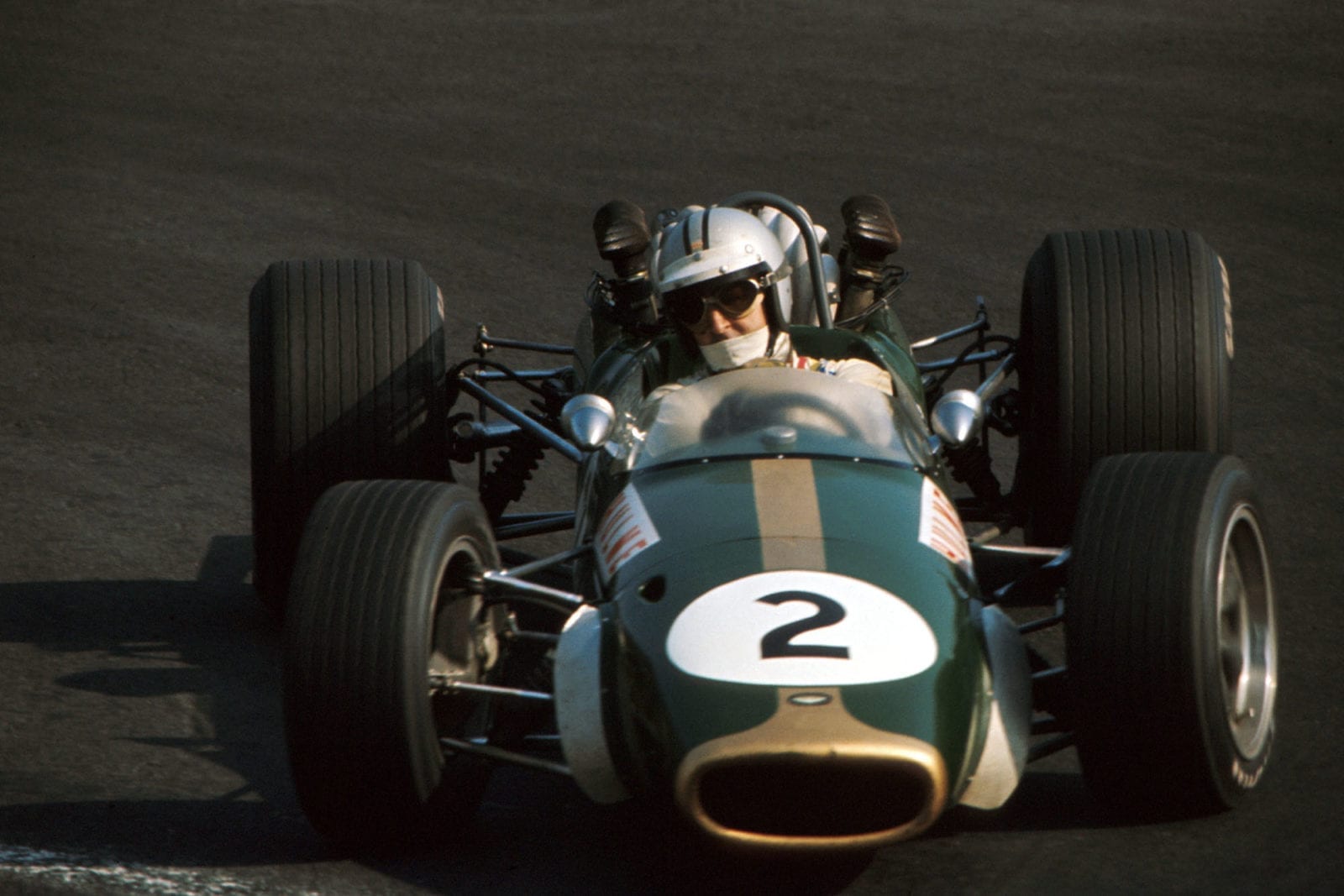
Denny Hulme finished 3rd in his Brabham-Repco, scoring enough points to win the championship
Motorsport Images
Twenty entries were invited for this year’s Mexican Grand Prix, which took place at the same time as the Mini-Olympics. Of the 20, 19 were all ready for the first four-hour practice session on Friday afternoon, the one missing car being the Cooper down to be driven by Rindt. This was withdrawn due to a haggle over starting money which the Austrian driver demanded but no-one thought worth paying.
BRM had the three cars that they used at Watkins Glen. The two engines which broke rods had been back to England for a rebuild and the one in Stewart’s car was changed as a precaution. The new works V12 which was expected to run in Mexico for the first time had teething troubles when tested recently at Goodwood and failed to materialise.
Lotus had three cars for Clark, Hill and Solana, and again there was little change. One engine had been sent home for an overhaul, and on Hill’s car the USA race clutch problem had been diagnosed as a bent withdrawal bracket which reduced the length of operating arm travel. Mechanics had strengthened the small sub-frame on to which the rear suspension is attached, but Chapman brought over two sets of much more strongly constructed frames for Clark and Hill.
One of the problems at the altitude of Mexico City is that fuel vaporises at a lower temperature and therefore causes vapour locks. Cosworth had a simple fuel cooling system by-passing the surplus fuel from the metering unit back to the pick-up tank via the inlet manifold, which runs at something like 30º C. and is the coolest part of the car. This cooling system has been on the car since it appeared in Holland but this is the first time it has been of real value.
Ferrari had the same two cars for Amon and Jonathan Williams, who was being given his first Formula One drive, after the team’s fairly successful Group 7 run in the Can-Am race at Laguna Seca. Both F1 engines had been back to Modena for an overhaul and team manager Franco Lini was frantically trying to extract them from the customs on the night before practice. Both Brabhams were unaltered, one engine being out from England, the other having had a rebuild by the mechanics on the spot.
“Rodriguez was hobbling round on a stick, his face more pinched than usual, but he felt that when sitting in the cockpit he would be able to cope”
Coopers had only one car, this being the older, 1967 chassis used by Rindt at Watkins Glen. The engines had been back to Modena and Maserati recommended using the 36-plug, 36-valve version, so the mechanics had to find homes for all the coils, etc., on the older chassis. Rodriguez was hobbling round on a stick, his face more pinched than usual, but he felt that when sitting in the cockpit he would be able to cope. Dan Gurney had his Eagle 104 with new rear uprights to stop the repetition of the trouble at Watkins Glen. One engine was sent home for overhaul and another returned, indicating that there are now three serviceable Gurney-Weslake V12s. Each time the team has reached this situation one or more engines are disintegrated in a big way.
The Honda V12 was unaltered as far as the chassis was concerned, it being the same as at Monza, but the engine had several modifications to try to overcome the poor fuel injection. A new metering unit had been fitted and the fuel system overhauled to include extra filters.
McLaren’s car was unaltered and the BRM V12 engine, when it arrived back at Bourne, was found to have only a slightly bent valve. Beltoise had the Formula Two Matra which he ran in the US Grand Prix. This was unaltered and was hoped to be more competitive as the altitude would have less effect on a 4-cylinder engine than the multi-cylinder units.
The last four entries were the private owners: Siffert, in the Walker/Durlacher Cooper-Maserati which went exceptionally well in the US Grand Prix; Bonnier in his own Cooper-Maserati, now beginning to look rather tatty; Ligier in his Brabham-Repco fitted with his spare engine (the other being badly damaged at Watkins Glen); and last was Mike Fisher, who drove the ex-Graham Hill Lotus 33-BRM V8 at Mosport in the Canadian Grand Prix, and with a club event since, was driving this car for the third time.
Qualifying

New Ferrari boy Williams was delayed getting into qualifying while the team worked on his car
Motorsport Images
Practice started 20min late. Fisher was late getting started as some gearbox parts only arrived as practice began. Solana’s Lotus was found to have bearing trouble in its Cosworth V8 engine and so mechanics started fitting the spare engine as practice began, while Ferrari had prepared Amon’s car but still had two hours’ work to do on Williams’ car.
First away were McLaren, Brabham, Hulme, Gurney, Clark and Surtees. After a few laps they were all in with mixture or overheating problems. Amon complained about something breaking at the back end, but nothing was at first visible and it took some time to discover a fault in the gearbox, which was then changed.
“Clark’s Lotus was the first car to show its pace and he was very quickly down to 1min 51sec”
Clark’s Lotus was the first car to show its pace and he was very quickly down to 1min 51sec, with Brabham a second behind. This was well inside last year’s record by Ginther in the Honda of 1min 53.75sec (158.241kph). Practice had only been going about an hour when the annual dog stories started. Spence said two were rushing around on the other side of the circuit and, even while he was talking, one appeared on the track in front of the pits, which had Beltoise avoiding on to the grass.
Most of the drivers were complaining about the slipperiness of the circuit, which was not so much due to an oiling in the opening laps, but to a film of dust due to lack of use.
Solana was given the chance of practising in Clark’s car and the team pulled him in after only a few laps when his time was down to 1min 52.86sec. When the second Ferrari was ready it had Amon’s number put on and Williams didn’t get a chance to practise as it was taking a long time to get Amon’s car repaired. Surtees was a lot happier with the Honda engine, but it was boiling hard, so a larger radiator was fitted. McLaren was having very few problems, for the mixture cam fitted back at Bourne was right.
However, Gurney was not getting the right mixture for a long time and then he found that for no apparent reason the car was oversteering very badly and he likes a car that understeers slightly. Many laps were put in trying to sort out this problem with tyre pressures and suspension angles being altered, so he never had a real “go”.
Hulme closed up on Clark’s time, which was now down to 1min 50sec, and as the temperature was dropping towards 5pm, so the times were decreasing. Spence had a connecting-rod break on his BRM and the team’s only spare engine had to be fitted. This meant that Stewart had to be careful if he wanted to start and the whole team relaxed. Brabham came by the pits and his engine blew up in a cloud of smoke, so when the car was pushed in work began on fitting a new engine.
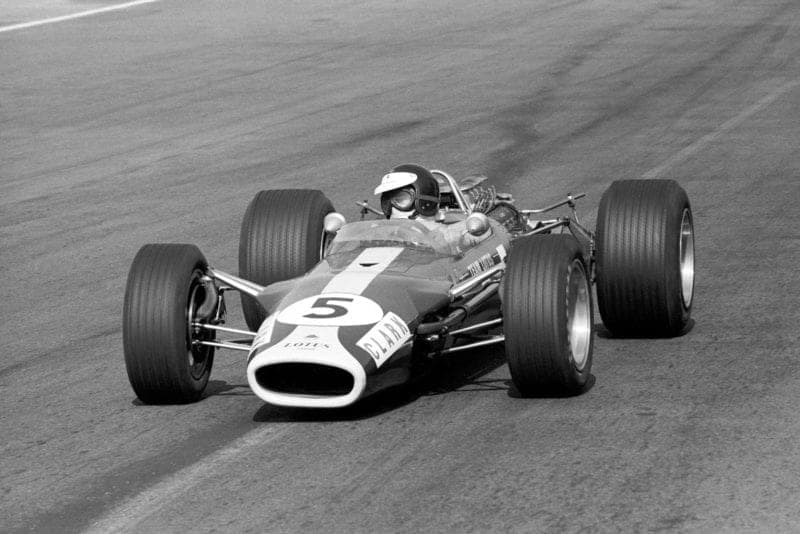
Clark and Hulme traded fastest laps
Motorsport Images
Clark bettered his time, coming down to 1min 49.80sec, and almost immediately Hulme clipped off 0.01sec. It was now that Clark stated that in the last minutes he would drop the times into the 1min 48sec bracket, and 10min from the end of practice he did just that, with a time of 1min 48.97sec. Hulme and Clark were the only two under 1min 50sec on this first day; although Gurney, Hill and Brabham were not far off.
Second practice was much cooler, with haze keeping the temperature down. Williams and Rodriguez were off immediately the track was open. After a few laps Williams came slowly into the pits with the glass-fibre nose of his car damaged. He had been concentrating on where the track went instead of the handling of the Ferrari and had hit a marker tyre. Overnight there had been a stir around in Team Lotus for Clark’s usual car, 49/2, was numbered for Solana and Clark was driving the first car, 49/1 with the new engine. Hill’s 49/3 was smoking badly and an oil pipe was found to be fractured.
Brabham had fitted larger extractors behind the radiator and one BRM had its nose cut back to the radiator. Amon had stopped without fuel at the hairpin and when the car was got back to the pits it was discovered that fuel was escaping from the fuel pump, and another was fitted. In the first two hours only Clark managed to get under 1min 50sec and it became obvious that most teams were waiting for the last and cooler hours.
Surtees was trying very hard. His engine was on all 12 cylinders down the straight but the pick-up from the corners was still suspect and was losing him at least a second a lap. Brabham and Hulme both did a few laps but nothing serious until the last hour; then they both got down into the 1min 49sec time, with Brabham slightly the faster.
Clark went out to put in some fast ones and got down to 1min 47.56sec (167.441kph) with a bad pick-up out of the hairpin, so his next lap should have been quicker but he passed Hulme near the pits and lifted off before doing a predicted 1min 46sec to stop pulling the Brabham higher up the starting grid.
As Clark sat on the pit counter in the last 10min. Hill, Gurney and Amon went out. Hill was unable to get within one second of Clark’s time; Gurney gave up, unable to break the 1min 48sec time, while Amon’s last lap was given by the team at 1min 47.9 sec ⎻ in fact it was four-hundredths of a second the wrong side of 1min 48sec.
Rodriguez complained of clutch trouble at the end of practice but nothing could be found wrong and it was then announced the pain in his leg was stopping him depressing the clutch fully after some time. Ligier’s engine had cut suddenly on the far side of the circuit and he coasted in with what he diagnosed as bearing trouble. The engine removed, laid on its side and the sump removed. Then one of the bearings was taken out and seemed in perfect condition. The engine was turned and found to be quite loose. The mystery was solved when it was found that the tank was empty, and because the engine blew up at Watkins Glen, Ligier assumed the same thing had happened. Most of the other mechanics came and had a look as Ligier’s two mechanics refitted the engine and a certain amount of laughter was forthcoming.
Race
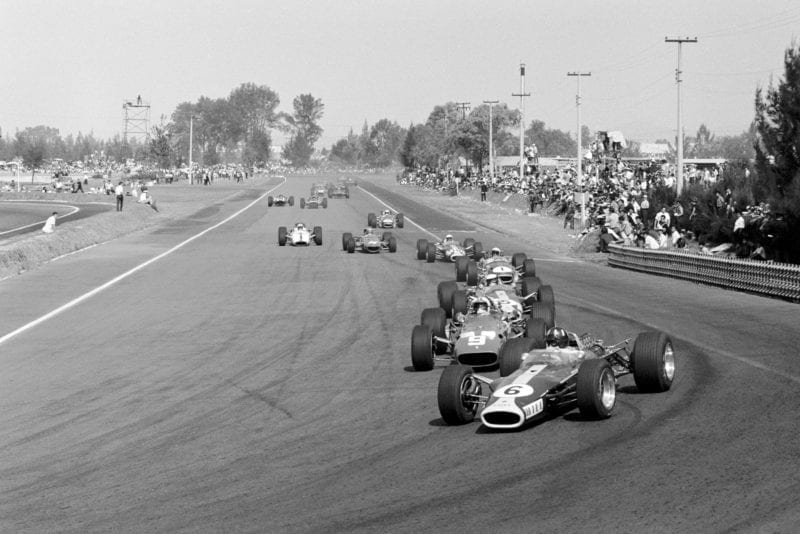
Hill leads at the start
Motorsport Images
With the end of practice race preparation began. On Clark’s 49/1 Lotus the monocoque was found to be cracked, again at the right-hand lower radius arm mounting point. This part of the monocoque on this car had been repaired when buckled at Mosport in practice, earlier by Hill in testing, and earliest of all on the first day at Snetterton when Mike Costin gave the brand new car full acceleration from the hairpin and pushed both lower radius arms somewhere-into the monocoque.
Race day was clear and had all the symptoms of developing into a very hot day, which in fact it did. This added to a last-minute frenzy to cut more louvres and extractors in bodywork and enlarge radiator openings. Brabham went one stage further and two hours before the start his mechanics were shaping a new water pipe which they fitted along the outside of the cockpit.
On the back of Solana’s Lotus the mechanics had fixed a rod across the back joining the top link mounting points to spread the load. There were three preliminary saloon car races which added a further film of oil to what was there already. The big crowd got through the fences all round the circuit and sat on or in front of the safety bank, while 800 soldiers sent to control them merely joined them.
After being presented to the Governor the drivers went on their warming-up lap. Going very slowly was Fisher’s Lotus-BRM which earlier had broken the diaphragm in the metering unit and in fitting a new one had disrupted the opening which meant they could only get 4000 revs. As there was no chance of repairing the unit in time for the start, the car was wheeled off the dummy grid and retired.
“The double wave caused Clark to hesitate a moment so his engine did not pick up”
At 2:30pm the revs, rose and with a double wave the flag was dropped. The double wave caused Clark to hesitate a moment so his engine did not pick up and Gurney, right behind, ran the nose of his Eagle over the Lotus exhaust pipe, bending this, puncturing his own radiator and damaging the glass-fibre nose. With an almost stalled engine, Gurney threw up an arm and the field swept by him. Amon led until nearly the end of the straight when Hill went by him into the first corner.
As the cars completed the first lap, Hill was leading from Amon, Clark, Brabham, Solanai, McLaren, Surtees, Hulme, Siffert, Rodriguez, Spence, Williams, Stewart, Bonnier, Beltoise, Irwin, Ligier and, some way behind pouring water on to the track, came Gurney. Clark’s hesitant start did not keep him back for long and on lap 2 he was in second place and on the next lap he was ahead of Hill, a position he held until the end.
While passing Hill, Clark’s clutch operation stopped working and for the whole race at record speeds he drove without it. The only place that it was noticeable was the approach to the corner at the end of the main straight. Here his line was quite different to practice and he did not change down at all until he was right round the corner.
On the second lap Surtees and Hulme passed McLaren and it was obvious Hulme was not driving in his usual forceful way and was keeping well out of trouble, for he only had to finish one or-two places behind Brabham to be sure of his World Championship.
Down at the back of the field Irwin passed Beltoise and Gurney was close behind Ligier, but his car was still pouring water. Next lap the Eagle was in 17th place but not for long, for on the fourth lap all the water had gone and the engine began to overheat. Ligier was having handling trouble and the link from the rear roll-bar to the wishbone was hanging loose, making the car unstable on some corners.
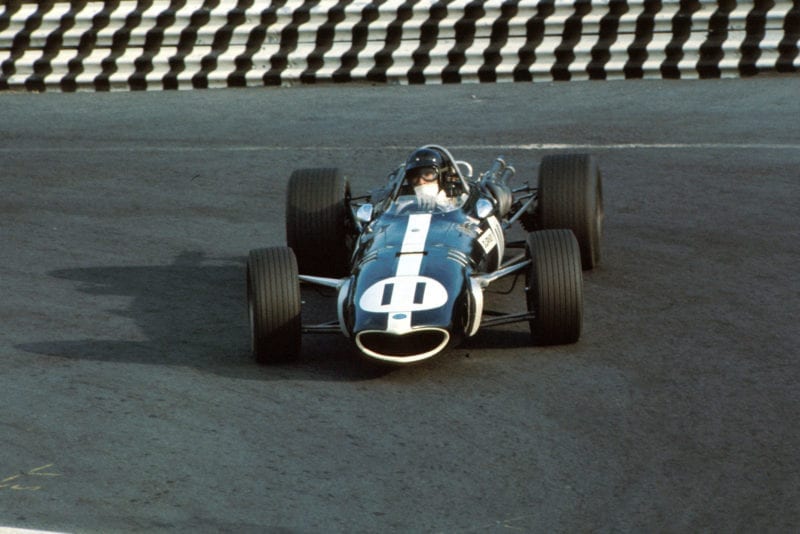
Gurney retired early with a water leak
Motorsport Images
On the fifth lap Spence passed Rodriguez and Beltoise got ahead of Irwin, whose BRM was smoking badly front an oil leak. On the same lap both Irwin and Beltoise went by Bonnier which put hint back into last-but-one place. On lap 6 Clark was 7 sec. ahead of Hill, who, in turn, was 2sec clear of Amon and Brabham, Solana, Hulme and Surtees.
“Solana’s fifth place was an extremely competent effort for a driver who only runs in Formula One once or twice a year”
The latter two switched places on this lap and were close together 15sec behind the leader. Solana’s fifth place was an extremely competent effort for a driver who only runs in Formula One once or twice a year. McLaren was eighth, 25sec down, then Rodriguez 31sec down. Next, and close together, were Spence and Siffert, 33sec behind, with Williams and Stewart 8sec behind them. Ten seconds further down was Beltoise, who in one lap had pulled 3sec away from Irwin.
On lap 7 Stewart managed to pass Williams and for five laps the order remained constant. With 12 laps gone Hulme cautiously slipped by Solana putting himself about 6sec behind Brabham, a position he was quite happy with. On the next lap Solana failed to appear. The pin which connects the lower link to the left front upright had broken on braking for a left-hand corner and in turning the whole thing broke the top of the upright. Fortunately, in a left-hand bend all the weight was on the right-hand wheels so he was able to stop on the grass without doing any further damage, nor scooping up those spectators sitting in front of the safety banks.
Three laps after Solana had gone Williams and Beltoise passed Stewart, who came into the pits running on only 14 plugs and without the use of his rev-counter which had broken. While he was in the pits Hill went missing and Amon was now in second place. After most of the field had gone by the Lotus crept into the pit area with a dead engine.
When the mechanics had pushed the car to its pit they discovered that the left-hand drive shaft had broken at the yoke at the wheel and in flailing around had carried away the damper-spring unit. Hill was not looking very happy but he would not have lasted much longer for when the car was being drained of liquids for the air freighting to England it was found that there was barely any water left.
By lap 20, Clark was 21.5sec ahead of Amon and 29.5sec ahead of Brabham. Hulme was 43.5sec behind the leader with Surtees 51sec down and McLaren 63 sec. down. Stewart, in last place, retired when his engine began to vibrate as it has done before, just as a connecting rod is about to break. Also it was found that the monocoque was cracking at the bulk-head.
The race settled down now until the halfway stage when Irwin retired with no oil left. Clark was now 34sec clear of Amon and 47.5sec ahead of Brabham. Hulme had dropped back to 72sec behind, while Surtees was 80sec down. Next, and about to be lapped, came McLaren. The only close racing which was now taking place had just started between Williams and Beltoise in 10th and 11th places. These two were evenly matched and swapped places right to the end. Williams, with the much greater power of the Ferrari, would pass on the straight only to lose what he gained on the corners and braking.
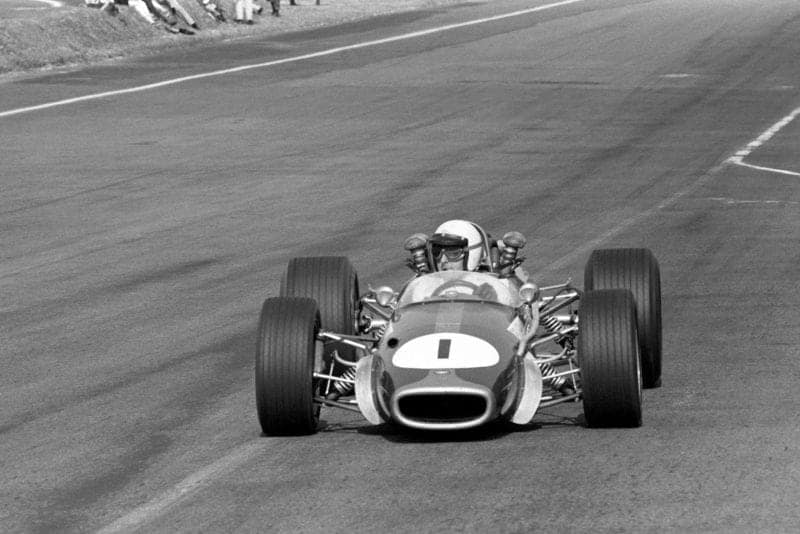
Brabham needed to win with Hulme 5th or lower to secure the championship
Motorsport Images
For a further 10 laps things remained constant. Surtees was having some differential trouble which made the car weave on the straights. Then McLaren, who was in sixth place one lap down, came into the pits with oil pressure trouble. On right-hand corners there was no pressure showing although he had plenty of oil in the tank. The fuel and oil pressure pipes were switched and he went out for another lap, but the same trouble was still there. After some minutes of fiddling, he again went out for another lap, then on the 45th lap he retired with a stuck pressure relief valve somewhere inside.
“Rodriguez was tiring and very nearly killed two young spectators who decided to run across the track”
Spence, in the remaining lone BRM, caught and passed Rodriguez, who was tiring and who very nearly killed two young spectators who decided to run across the track to some friends on the other side.
As the race settled into the final stages Clark set a new lap record in his 52nd lap of 1min 48.13sec (166.466kph). On the 58th lap, Siffert went by the pits very slowly, his engine sounding terrible. One of the small plastic oil pipes between the vee had collapsed with the resultant cutting off of oil to the cams and one of these seized, which meant he did not complete the lap.
Hulme was lapped by Clark on lap 62 and on the next lap Amon tailed to appear. The second place Ferrari had run out of fuel at the hairpin. Amon climbed out and took off his helmet—a very unhappy young man. The leaders swept by him and then he suddenly heard his ticking fuel pumps slow as they found some more fuel. The engine started and he headed for the finish line. Several times the engine cut and then re-started and, as he reached the line, Clark went by to take the chequered flag.
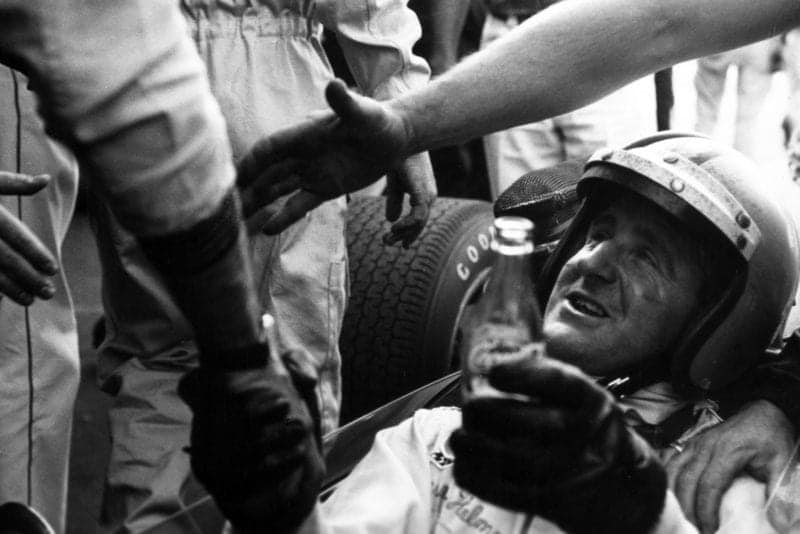
Hulme is informed he is World Champion
Motorsport Images
On the lap chart Amon appeared as fifth, two laps down. Brabham came second, the only car to remain on the same lap as the winner and 1min 26sec behind. One lap down were Hulme, who with this result clinched the 1967 Drivers’ Championship, and Surtees.
On the same lap as most people had thought Amon was, came Spence, Rodriguez, Beltoise and Williams. The F2 Matra driver had out-driven Williams on the last lap to cross the line just ahead. The only other finishers were Bonnier and Ligier who were four laps down.
The official results took a long time to prepare for, according to the regulations, the last lap of any car must be within twice the time of the winner’s fastest lap and Amon’s last lap had been more than this, so, after much deliberation, the stewards disallowed the Ferrari’s last lap, which put it three laps behind and between Bonnier and Williams in ninth place.
Clark once again proved what a great driver he is and what a lucky decision it was to drive 49/1 instead of his usual car, 49/2, which would have broken down on him.—M. J. T.
Mexican Mumbles
- Next year’s race is being held week later so that it doesn’t clash with the Olympic finals.
- The Honda, the Cooper-Maseratis and the BRMs are-all reported due for the scrap heap, although they may have to be resuscitated for South Africa if the new cars are not ready.
The Puff Of Bacchus
Our Editorial under this heading last month has met with widespread agreement. The very few criticisms of our objections to breathalyser tests are based on the assumption that any measure which appreciably reduces road accidents is to be applauded. But how many serious accidents will these random tests prevent? It must be taken into account that to be effective a large number of policemen will be required to operate them, who, in a time of increasing crime, vicious demonstrations, fights in cinemas, disorder at football matches and in trains, etc., not to mention almost daily sex-crimes, should not be spared unless definitely effective results are obtained. In the face of this argument, how many accidents will breathalyser tests prevent? Mrs Castle doesn’t seem very sure herself. When the idea was first mooted, and rejected, she spoke of definitely saving between 18,000 and 32,000 casualties a year. But now that the thing has become law, she talks in terms of preventing about 1,945 serious casualties a year. Some reduction!
Tyres For Older Cars
After writing the article about Dunlop’s valiant efforts towards keeping vintage and veteran cars properly shod (Motor Sport, last month) I noticed that Goodyear advertise their Marathon tyres as “the economy price tyre for the older car market.” So while I was at the Motor Show, I ascended to the gallery where 13 different makes of tyres were displayed to ask about this. I discovered that these Goodyear Marathons are made in the following sizes’. 5.25 x 16, 5.50 x 16, 6.00 x 16, 4.50 x 17 and 4.75/5.00 x 17. So, while they are applicable to some pre-war cars, it is Dunlop on whom the majority of veteran/Edwardianlvintage-car enthusiasts are dependent for keeping their wheels properly shod.—W. B.
The Things They Say…
. . . . I believe Honda in Britain are over-optimistic in reckoning to sell at least 1,000 of these cars (the N600) a month in 1968. Their new and raw retail network will never be able to cope. Moreover, I feel the Honda mini’s publicity has been overdone. On the evidence of the cars I have seen, it is not as well finished as the BMC equivalent and is rather more spartan.”—Maxwell Boyd, writing in The Sunday Times
* * *
“Fast ladies attract little attention at the circuits these days, excent perhaps Mrs. Bluebell Gibbs, who was racing before the war and reminds bystanders of Grandma in the Beverley Hillbillies.” — Philip Norman, reporting on club racing in The Sunday Times Magazine.
